Anderson Frank has just released the third edition of its annual NetSuite Market Trends & Salary Survey. Each year the company, which specializes in recruiting IT professionals, conducts this study to provide a clear picture of what those working within the NetSuite ecosystem think and experience. The report also offers great insights into NetSuite partners’ perspectives on the user community, as well as comparisons to similar data points from last year’s survey, which I summarize below.
Solutions NetSuite Users Migrate From
Overall migration patterns haven’t changed too much year-over-year. Customers that have switched to NetSuite primarily for ERP/accounting are, once again, most likely to come from the ranks of Intuit QuickBooks, Sage, and Microsoft Dynamics.
This year, partners indicated that 39% of migrations came from Intuit QuickBooks, dropping slightly from 42% in last year’s survey. Sage accounted for 10% of migrations, compared to 6% in the prior year. Respondents indicated that 6% of new users came from Microsoft Dynamics, compared to 7% last year.
CRM migration patterns have also remained fairly steady. Users are most likely to come from Salesforce (25%), Microsoft Dynamics CRM (12%), and SAP CRM (4%).
This year’s survey was the first to ask about eCommerce software. Results show that 27% of new NetSuite ecommerce customers moved to NetSuite from Magento, 12% of respondents switched from Shopify, and 4% migrated from WooCommerce.
Implementation Considerations and Benefits
 Partner respondents indicated that the top three considerations customers take into account in determining whether to make the switch to NetSuite include: managing data migration, adapting to change, and end-user training.
Partner respondents indicated that the top three considerations customers take into account in determining whether to make the switch to NetSuite include: managing data migration, adapting to change, and end-user training.
NetSuite’s functionality was cited by 68% of participants as the main reason that customers decided to go ahead with their implementation, followed by the ability to move business processes to the cloud.
Partners indicated that NetSuite implementation generally takes between four to six months, although some deployments are completed in as little as 45 days. The main factors that slow down implementation include: poor planning in advance of implementation, unforeseen customizations, and issues with data migration.
 When asked for the benefits they’ve seen after deploying NetSuite, improved functionality, streamlined business processes, improved work processes, and better efficiency all scored highly.
When asked for the benefits they’ve seen after deploying NetSuite, improved functionality, streamlined business processes, improved work processes, and better efficiency all scored highly.
What NetSuite and Third Party Functionality Customers Use
Not surprisingly, NetSuite ERP is the most frequently deployed module, with 87% of respondents reporting that their customers have adopted it. 56% are using NetSuite OneWorld, and 44% have deployed NetSuite CRM.
After that, adoption drops off significantly for other modules. Partners indicate that 17% of their customers use SuiteCommerce; 8% use NetSuite OpenAir, 3% have deployed NetSuite PSA; and 3% have adopted SuitePeople.
 It’s also interesting to see what third-party apps NetSuite customers are most likely to be using. Salesforce tops the chart, but integration vendors such as Celigo, Dell Boomi and Jitterbit feature prominently, indicating that many customers are integrating the ‘long tail’ of additional software solutions into their NetSuite environments to solve a broad range of specific vertical and horizontal niche requirements.
It’s also interesting to see what third-party apps NetSuite customers are most likely to be using. Salesforce tops the chart, but integration vendors such as Celigo, Dell Boomi and Jitterbit feature prominently, indicating that many customers are integrating the ‘long tail’ of additional software solutions into their NetSuite environments to solve a broad range of specific vertical and horizontal niche requirements.
Perspective
The Anderson Frank NetSuite Market Trends & Salary Survey is available to download now. It’s a handy tool for any small or medium business (SMB) customer looking to get a valuable insight into NetSuite trends, and for NetSuite partners that want to benchmark their own experiences against that of the larger ecosystem.
© SMB Group
Source: Laurie McCabe’s Blog
